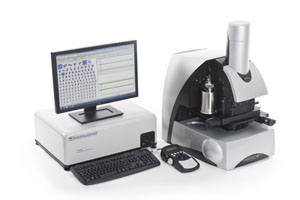Supplementing cascade impaction with these additional particle characterization techniques allows developers to quickly acquire and use particle size, shape, and chemical composition data to answer questions such as:
• Is the drug failing to disperse to a respirable size because the API particles have cohered?
• Is poor dispersion associated with a failure to successfully strip the API from the carrier?
• Is the carrier breaking up during dose delivery?
• For combination products, are the APIs present dispersed in a similar way?
• Is dose emission from the device a steady, progressive process or almost instantaneous, delivering the dose at a much higher concentration over a shorter timeframe?
• Is dispersion flow rate dependent or not?
Increasing informational productivity
Cascade impaction is a relatively complex and largely manual method that takes around 30 – 60 minutes to measure a single APSD. Then, the powder deposited on each stage of the impactor must be laboriously removed, prepared, and analysed by HPLC in order to quantify the amount of API present in each cut.

MDRS measures size, shape and chemical identity and can be used to assess the mechanisms of de-agglomeration and to boost the information gathered during cascade impaction measurements
In product development situations, where compendial testing methods are unnecessary, MDRS offers a way of increasing the information gathered from cascade impaction measurements. A specialized disc inserted into each collection cup can be used to transfer each sample directly into the MDRS instrument without any additional sample preparation. Because the test is non-destructive, the samples can then also be subjected to HPLC analysis if desired. MDRS can also be used independently of cascade impaction, with any standard dispersion technique, for component-specific formulation analysis, and for deformulation of a DPI, a critical step in generic development.


